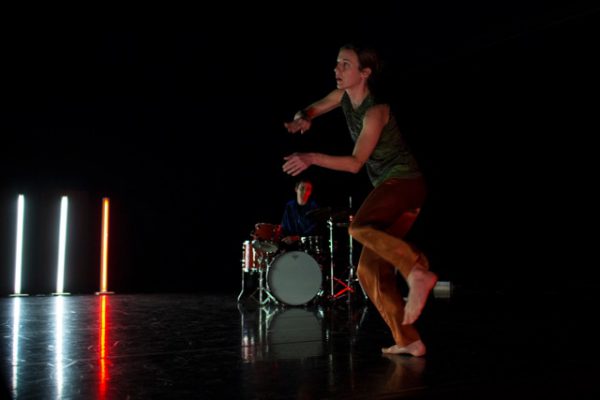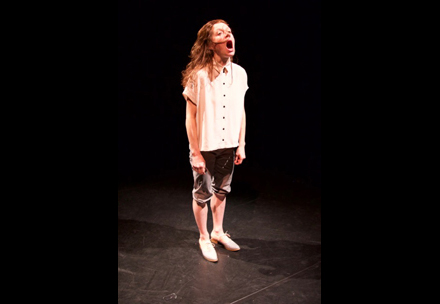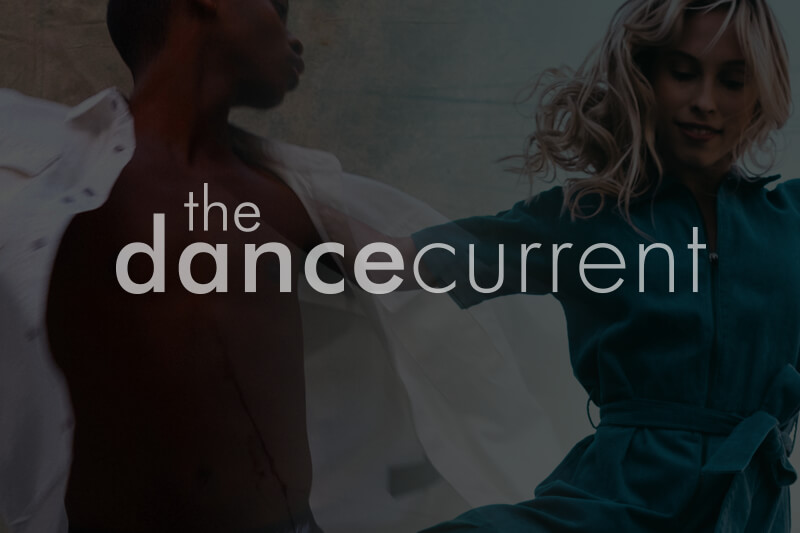While in Europe in June and July of 2016, I spoke with contemporary dance artists in their mid-career and beyond about how they sustain themselves and how they move forward — physically, creatively, psychically, practically. I focused on Brussels, Belgium, and Berlin, Germany. I am continuing these conversations here, at home, with Canadian dance artists. Below is the beginning of a series of portraits of artists carrying out their lives in dance.
Sunday, June 12, 2016.
Avenue Clemenceau in Anderlecht, Brussels, Belgium
David Zambrano, Mat Voorter & Danielle Baskerville
I sat down with David Zambrano and Mat Voorter in their home on Avenue Clemenceau in Anderlecht, Brussels, in Belgium. Zambrano, fifty-six, and Voorter, fifty-one, work internationally as dance artists and are based between Belgium and the Netherlands.
David Zambrano People ask me, ‘Do you still dance? How is that possible?’
Danielle Baskerville In nearly any other art form, it’s accepted that it takes ten years, twenty years, thirty years to become a great artist. It requires the work, it requires the time. But in dance…
DZ It used to be that way in dance. It really did. When Trisha Brown went uptown, to 21st Street, to City Center, for the first time — uptown but it was still mid, mid-Manhattan — I was there, and she was coming downstairs, and there was a woman who called to her, saying, ‘Trisha, finally you’ve made it!’ And Trisha said, ‘Yes, and it took me twenty years.’
I was, like, ‘Wooooah. Better not complain.’
After that, everything changed. Management came into the dance world and wanted to make stars, like in popular music. They wanted to make a new star per year. But then they are gone.
DB And the role of producers in Europe?
DZ One of the requirements of the production houses for dance here in Europe is that you need to be young. Some of my students told me they wanted to go to Belgium to work on the production houses to support young choreographers. I asked, ‘What about the old ones?’ They said, ‘Well, the old should already be established. If not, they haven’t made it, then we don’t think it’s necessary.’ I told them if you make a production house for older people, it would be a big hit, because nowadays they are totally left out. That would be a fantastic idea.
And some people do think so. But those people are mainly in the world of conceptual art. You have an old body, naked, or no, or moving a little bit, with hands like this, old ladies or men, which is nice, interesting, but in the training, in the regular life of the dance, in the scene, no. Very seldom. That is a real pity.
Mat Voorter It happens in mid-career; it can happen very quickly, that someone is already too old. I fear this also puts pressure on youth. If they are five or ten years out of school and they haven’t made it yet, forget it. And that is a shame.
DZ Also, and mainly, there is the standard of what is supposed to be beauty. It has invaded our minds. We don’t want to see someone who is over fifty, who has a little belly …. It’s horrible … In theatre, yes. The older, the better.
DB It doesn’t make any sense for dance to perpetuate this. We should know, more than any other form, that the beauty of the body is a constant.
DZ Yeessss. And we go through the ages. We get transformed, but still we are beautiful. The more we accept the changes, the standard of beauty moves with us. But if we are consumed by the image of the Hollywood stars, we think no one sees us if we appear otherwise. I think it is sad. To have someone like Marina Abramović, who was fighting so much for the political body, to go to Brazil to get plastic surgery in order to be ‘an example for all of us’ … I don’t want to follow that. It is telling me that I’d better operate on my nose, to get a nice nose, before you get too old, and be sure to change the colour of your eyes, and get some more hair on top, and so on and so on, otherwise, otherwise what?
Also, youth are easier, and cheaper, and …
DB Less demanding?
MV We are less likely to ask an older artist, can we negotiate the price? Or would you like to do, or not do this? We have a lot of preconceived ideas about what an older dancer would demand, or say, or think.
DB I have often felt that Europeans dancers ‘age’ better. There are more European companies for aging dancers, for example, and you have governmental support structures that are simply unheard of in Canada, such as the Statut des Artistes here in Belgium and a similar system in France.
DZ It helps, the support. But still it is not for everybody. In Brussels right now — I have been teaching here for awhile — there are a lot of dancers floating, many of whom don’t belong to the Status des Artists, and this means they still have to work as waiters. Those who manage to perform in companies, yes, they can get the Statut des Artistes, and they get it forever.
DB Mat, what support structures are there for you in your native Holland?
MV There exists a special pension fund for artists, one that can be accessed early. It exists with the idea in mind that as an artist, you may not do the same thing for the rest of your life. As a dancer, you will almost certainly be making a change. This money can help you make a change, sometimes into another profession. I am not part of that. But I can receive a period of social security money if I have worked enough. In that way I can pass the gaps in between projects. It also means that sometimes I can do work that I want to do even if it doesn’t pay that well.
In reality each place has its advantages and disadvantages. In Belgium, sometimes the Statut des Artistes can lock people in. It provides a base income form of security that can cause people to lose their motivation. For many others, of course, it is extremely helpful.
DB In Canada we have the Dancer Transition Resource Centre, which is a remarkable organization that helps dancers make transitions into, within and from performing arts careers. We also have arts councils and organizations, public and private, that offer support. We don’t, however, have access to consistent financial support that sees us through our working lives, let alone into any kind of comfortable retirement.
David, how is your choreographic work supported?
DZ I love to work with improvisation. I give strong value to the work of right here, right now. I have practised this for more than thirty years, but it is not well supported. To many, the word improvisation can mean absolutely nothing. Meanwhile, we all want to know what it means to really enjoy the right here, right now, the present moment. But because your work needs to be well understood, well articulated, so that you can repeat it and then you can sell it, working with improvisation can be very difficult.
I don’t have any problem with set choreography, but my requests for subsidies have been rejected for more than ten years. Faced with that, I say, ‘Okay. I don’t apply anymore.’ In that way I am out of the establishment of professional dance.
Thank God I love to teach. I have taught my whole life. Through that I can finance my projects and bring people I want to work with here, to Brussels or Amsterdam. When I invest in a dance research, it’s like investing in a study — you learn more about yourself each time. So I live a little bit parallel to the establishment of dance. Here, in Brussels, I am well-known as a teacher, a little bit as a performer, but I don’t get support to make work, so I must make it myself. We work hard.
MV David has continuity with his work, but for me, I work in projects, with different people. With Thomas Hauert, for example, with whom I have worked for many years, always project to project. I know I will be in his next project in a year or two, for example, and that provides a kind of continuity. But each time I need to ask myself: is it the kind of physicality I want to be engaged in, in my aging and where I am at? Does the constellation of the group work? These questions are ever-present, but at this stage, they are easier. I know that I am always asking them, at every turn. They are a part of it. Inside of these questions, you hopefully find your stream.
DB Is your quality of life getting better?
DZ With age, you mean?
DB Yes, with age, in dance.
DZ I must say, yes. We bought this house based on our profession, not because we come from families that can give us financial support. I pay into my pension, so later in my life that will be helpful. And we have creativity in our lives here. As a place to live, for health insurance, for possibilities for the future as we get older, it is good for us here.
DB Do you feel the need to be constantly reinventing yourselves, or are you on a track that deepens?
DZ I think it’s a bit of both. In my case it is both.
MV The trust must be there, of the past. When you go onstage you need to know what you can do, and at the same time you must always be challenging yourself: Can I do it again, stronger, newer, how else? The challenge is always there, the nervousness must always be there, and at the same time a certain confidence needs to grow — confidence that you can tune into your intuition and allow things to happen.
DB Have you had great mentors, and how do you feel about being a mentor for others?
DZ Simone Forti. She has helped me see many things. It wasn’t a conscious thing between us, rather it was the way she taught, the way she transmitted information everyday, in rehearsals, in class, in her workshops. Just by watching her expressions and the ways that she communicated, I would be involved in a fantastic performance. Everyday, in front of my eyes, for an audience of one or five or twenty people. Seeing her perform, nothing was different, yet everything was so full — as full as it could be. Every single time. I wanted a practice like that for myself.
MV She is eighty-one years old. We saw her perform a month ago in Holland — incredibly inspiring.
DZ In some cultures, such as in Japan, with Butoh, the older performers are so superb. To arrive at an age with that kind of knowledge, in the full expression of the movement, is phenomenal. Another woman who has been incredibly stimulating is Anna Halprin. She is in her nineties and she still performs. She went all the way with dancing, all her life.
I have taught many dancers, worked with them, coached them, followed them, supported them financially. Like family. I’m not sure if I am a mentor for them, but we have been touched artistically, and in a human way, by each other.
DB What are your physical practices?
DZ For me it is the teaching. I do it often, almost every week, and all over the world. The way of teaching that I have developed has a lot of me involved. That keeps me in shape. When I do research I practice the shaking from QiGong, a little bit from yoga. But I have to admit, because of age, that the body changes, and gets wasted — pains are there from knees to lower back to ankles, to feet, to neck. And because I love what I do, I forget to take a rest, and I get injured in the sense of an overworked immune system. Stress, too much travelling, too much change. I try to stay balanced by eating less acidic foods, like sugar and alcohol. And I don’t like the nightlife so much, I like the daylight.
MV You are fifty-six now, but you move like someone from a younger decade in terms of speed and flexibility — you are in amazing shape. My life is less constant. I will have intense periods when I am careful to buildup before, and then there will be a build-down. Right now, for example, I am busy with costumes for the next few weeks, and so I will have a very different relationship with my body. I need to take care not to mess it up — each time I need to find a way, always a little bit different.
DB One more question. Have either of you gone through a real turning point, a time when you may have gone in another direction, but you didn’t?
MV I have this interest in costumes. It came somewhere along the way. One summer working with David I thought, ‘Well, what are we going to wear?’ And I had ideas. It worked well and I got pleasure from it — it is somewhere for my eyes go to. I also work in scenography. For me, being creative means many things, and dance is one element. In some projects I also sing, and I take joy in that; it can take me into a whole other world. But when I come back to movement, I don’t ever want to let it go. If feels good and right and I feel with the audience’s response that something is communicated. As long as I have that sense, and have the joy in there, and some support, then I will keep it in my life always.
DZ I had two turning points. One was from hetero to homo. I had to change my whole world, my environment. I had to leave my home country of Venezuela. My family. And the second one was from science to art. And they pretty much came one after the other. That was pretty interesting. I was always dancing, of course, but had never thought to be a professional. So having made those two big changes, everything in my life was smoother.
It has never entered my mind to stop dancing, or even to be tired of it. Actually, it has gotten to be more and more and more and more. It is richer and richer and richer and richer.
When I was fifty, I took the whole year to reflect about what I was going to do. How to ‘update’ myself, how to continue in this profession. I got some ideas, and at the same time, I got recharged. I’m getting older and closer to death and I want to enjoy it more and more. In that time I also decided to go back to painting, something I have always loved to do. But I must say, even when I paint I am thinking of a hand dance. Dance is always there, no matter what. I have learned to see dance in every aspect of my life.
David Zambrano has been making dance for over thirty years. In his pursuits as both a creator and educator, Zambrano has visited sixty-three countries, worked with thousands of dancers and has performed at hundreds of venues across the world. His pieces range from set choreography, structured improvisation and pure improvisation. Born in Venezuela, Zambrano spent fifteen years in New York and now lives between Amsterdam and Brussels where he continues to perform and teach worldwide. His improvisation is committed to art as a cultural exchange developing the creative process in a world without borders. Zambrano sees improvisation as an art and choreography as a vehicle to further develop his work in improvisation.
Mat Voorter was born in and currently lives in the Netherlands and Belgium and works internationally as a dance artist. He chooses to work in dance research with improvisation, and to perform. He designs as well as works with costumes, scenography and other things. He has ongoing collaborations with David Zambrano, Thomas Hauert/ZOO and Les Slovaks.
This conversation is the second in a three-part series. Read also perspectives from a mid-career dance artist in Canada from and other Europeans: Diving Deep with Valerie Calam and Diving Deep with Sarah Ludi.
Baskerville’s research is supported in part by the Canada Council for the Arts.
This interview was lightly edited for length and clarity.
Tagged: Contemporary, Conversation, Mid-Career, Belgium , International , Netherlands




